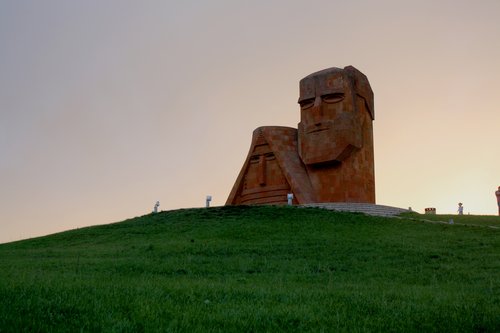Artsakh's tears – the disappearance of Nagorno-Karabakh

I have a small carving of an old woman wearing traditional head dress in the shape of Ararat Mountain (the holy mountain of the Armenians) and an old bearded man. It’s a copy of the huge carving in the city of Stepanakert, capital city of Nagorno-Karabakh, created from stone by Sargis Baghdassaryan in 1967. The official title of the carving is We are our Mountains but popularly referred to as Papik and Mamik or Grandfather and Grandmother. Under my wooden copy is the word 'Artsakh' in the unique letters of the Armenian alphabet. 'Artsakh' is the old Armenian name for Nagorno-Karabakh.
Nagorno–Karabakh was a devolved part of Azerbaijan during the Soviet period but with the fall of the Communist system the small country declared independence hoping to join nearby Armenia. Islamic Azerbaijan did not want to lose the region.
The Armenian Christians of Artsakh won their freedom in a bloody war between 1991 and 1994. When I visited the country in 2008 and 2009 I got the impression that the situation was fairly stable. I met the Armenian Bishop of Artsakh (a character similar to one of our former Bishops, Ivor Rees).
The most important spiritual centre in Artsakh is the Cathedral of Gandzasar, an architectural masterpiece built in the thirteenth century. At the same time many adorned stone crosses were produced in Artsakh, as well as beautiful manuscripts. In one decorated Gospel, Jesus and his disciples are around a circular table for The Last Supper. The table is an intricate cross with a circle around it which is similar to the Cross of Abraham in St. Davidns.
The decline started in 2020 with the second war at Karabakh. Azerbaijan is a rich country, enabling it to buy weapons and sophisticated military warfare. The armistice happened after Artsakh lost a great deal of land. Russia had promised to defend the people of Armenia but with the attack on Ukraine their attitude changed. The blockade by Azerbaijan on the only route between Armenia and Artsakh lasted for nine months without intervention from Russia. During one day of fighting earlier this year Azerbaijan claimed the remainder of the small country.
Around 120,000 ethnic Armenians fled to try and get refuge in Armenia, itself a poor country. Stepanakert is now Kkankendi. I am not sure how long 'Papik and Mamik' will survive. Armenians Cymru and friends have raised a substantial amount to help the children of the homeless refugees of Artsakh.
If you go to St.David's, will you please pray for them as you pass the Armenian memorial.
Diolch o galon. Thank you.
Patrick Thomas